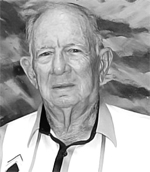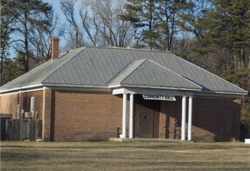
Interview with Mr. William Carter
May 15, 2004
Interviewed by Sandra M. Lowe
Mr. Carter was raised next door to the present Rescue Community Center, built in 1922 to replace the first Rescue School, which had high school classes. He attended the school in the fifth and sixth grades.

This is the Rescue Community Center, Saturday, May 15, 2004 and we are talking with Mr. William Carter.
Q. Mr. Carter, you grew up in Isle of Wight in which area?
A. Right next door to the school in Rescue.
Q. Did you have any sisters and brothers?
A. Two brothers.
Q. I assume they went to the same school right here?
A. Yes, they started there. My younger brother was 5 ½ years younger so; I think he started there.
Q. When you went to this school, how many grades did it have?
A. Six grades.
Q. How many classrooms?
A. Two.
Q. How was the building set up?
A. In the front door there was a room on the right and a room on the left. The room on the right had grades 1, 2 and 3 and the left was 4, 5, and 6. The auditorium was across the back of the school.
Q. Was the auditorium closed off when you were not using it?
A. Yes, and the door at the end of the hall went into the auditorium.
Q. How was the lighting? Where were the windows?
A. Windows were all on one side on each side of the building. There were about six windows on each side.
Q. Do you recall the names of some of your teachers?
A. My first grade teacher was Mrs. Bradshaw. She was from the Windsor area. The local assistant was Mrs. Nell Barlow. She was not a teacher. She was an assistant. When the teacher was teaching one grade the assistant was teaching the other. Two grades.
Q. Approximately what year would you have started here?
A. I was born in October so I did not start until I was almost 7 years old, so that was 1928 or 1929 when I started.
Q. Did you finish the 6th grade and then go on?
A. The 1st –5th grade I went to Smithfield. I could not get use to the change so I had to do the 5th grade all over again. Then I came back and finished up 5th and 6th grade and went back to Smithfield for the 7th grade.
Q. You said that there was an assistant here. Was she paid or volunteer?
A. She was a local resident. I don’t know if she was just a volunteer.
Q. Did she work with all the grades or mostly with smaller kids?
A. I think she switched back and forth.
Q. Do you know approximately when this building was put up and replaced an earlier building?
A. I think the earlier school was ½ mile up the road here. I have heard that but I’m not sure. I heard this one was built in 1922 that was the year I was born.
Q. Do you know how many rooms the other building had?
A. Just one I think.
Q. Did it have the same name, Rescue School?
A. As far as I know.
Q. Do you know if the County provided most of the funds for this school or the community?
A. I don’t know if it was the State or County, I’m not sure.
Q. When you went to school were you still living in the same house?
A. For the first four grades I lived right next door. Then we moved to Battery Park for a couple of years. That was the first year I went to Smithfield.
Q. I don’t need to ask how you got to school, you were right here.
A. When we moved to Battery Park I walked a mile each way.
Q. That was to go to.
A. Smithfield.
Q. Did you have any chores that you had to do before and after school?
A. We had a coal stove and I had to bring in the coal or wood, whatever we would heat with.
Q. Did you have any other chores that you had to do around the house or chores at school?
A. I had the privilege of ringing the bell once in a while.
Q. Mostly the bell was used at the beginning…
A. The beginning and at recess.
Q. How did your school day start? What do you remember about the process?
A. Most kids got here early and played in the yard. They rang the bell when school started, we pledged allegiance to the flag. Then the day started. We had recess in the morning and recess in the afternoon, short. We lay outside napping. The girl’s bathroom was on one side and the boys on the other, behind the school.
Q. I’m sure some of you played once you got back there and did you stay a little longer than you were suppose to before you went back in the building.
A. It was not like today, we respected our teachers. We were afraid of them.
Q. Laugh. How long was the school day here?
A. School started at 9:00 to 3:00 or 4:00.
Q. What can you tell us about your lunchtime?
A. Some kids brought lunches. I was right next door so I could go home for lunch.
Q. You described the inside. Is there anything you would add about the classroom? What else was in this section?
A. It was just one big room and a cloakroom across the back where we hung our jackets.
Q. Furniture?
A. Just a little type desk with a slide ___ on the side.
Q. There were round?
A. No, the arm came out _____; an inkwell was in the right hand corner.
Q. That part was all wood or did it have metal legs?
A. It was all wood.
Q. What do you remember about the lunch period?
A. I don’t know what went on in school because I went home for lunch.
Q. What can you tell us about your recess?
A. We played games and baseball. May 1st we had a may pole dance around the flagpole. We played marbles.
Q. Was your may pole dance an all day activity for the school and community?
A. We just made ribbons and braided them around the flagpole.
Q. You did not have any of the community people come in?
A. It was a school activity. Maybe local people who were close by came.
Q. What did you do for water?
A. In 1928 they put in a community water system. Before that there was an old oak spring over here a ways and we would carry water.
Q. Then you would just leave a large container in the building during the day?
A. I did not start in 1928 or 1929. By that time the water system had come in.
Q. Where were your blackboards? You said there were windows on both sides.
A. The blackboard was on the hall side.
Q. Was there anything about this building and your school days that stand out in your mind or anything that made your school different?
A. I remember the teachers more than anything else.
Q. Would you like to tell us something about the ones that you remember the most or why? What they did that affected you?
A. I just remember the names, but they were all good teachers.
Q. What can you tell us about discipline and punishment?
A. I remember getting cracked across the knuckles with a ruler. One time and I did not do it again.
Q. Do you remember what you did?
A. No. Talked in class probably.
Q. Anything about your playtime that stood out, or any activity that you did that you recall?
A. It has been so long ago. I can’t remember the small things.
Q. Are there any negative memories, anything you didn’t like?
A. I had trouble with one teacher in all my schooling, when I went to Smithfield in the 5th grade, Mrs. Baker. She did not like me and I did not like her. All the rest of the teachers I had were good.
Q. Personality clash?
A. Yes.
Q. Positive memories?
A. Well, there were a lot of those. We did not have much of a sports class because the children were so small. We played baseball right out here in front of the school in the Summer time when the school was closed. In high school I participated in all the sports I could.
Q. What were some of those?
A. Wrestling, track, baseball and choir.
Q. Are there any particular school experiences you would like to tell us about?
A. I had perfect attendance two years and also my last two years of high school.
Q. Would you give us a brief summary of some of the highlights of your life, what you did after school and up to this point?
A. Like most men my age, I was drafted in January 1943. I went to radio operator school. I finished part of that and Clark Gable came back to New York and was on a recruiting tour. So I and a buddy of mine from Indiana decided to take the test for the aviation cadet program. We both passed the written part of it. I passed the physical part and he didn’t. So I went on to become a pilot right at the end of World War II. As a pilot I did not get much action in World War II. But I stay in for two years and went over the Middle East where the fighting is now. I was stationed in Cairo, Egypt. We were closing down all of our bases over there from Turkey to India to all across North Africa. I got out in 1947 and went back to the Navy Yard and got into apprentice school. I kept my reserve commission. When Korea started they called me back. I went to Korea and flew 67 combat missions there. Then I was in Southeast Asia in the early 1960’s stationed in the Philippines. Then I retired as a Major and was gone from this area for about 40 years. I worked in Newport News and live in Denbigh. I retired from there and moved over here when my parents were getting bad. I took care of them until they died. I’ve been living here since then in 1986.
Q. Are there any other things that you remember about your school days that you miss or you just recall?
A. I can’t come up with anything outstanding.
Q. Well you have answered all or our questions. Thank you very much for coming out today. I have enjoyed talking with you and finding out more about this building and how it operated during that time. I hope that you will come see the new building when we open it up within the next 2 years.
A. Like I said there was a Mrs. Bradshaw was the 1st grade teacher. There was a Mrs. Pat Coffer, teacher of the 4th, 5tha and 6th grade at first and then there was Mrs. Nancy Grenade in Smithfield. When I left here she was teaching 4th, 5th and 6th.
Q. How did they travel?
A. Mr. Grenade was a resident in Smithfield, so she drove back and forth. And one of the other teachers stayed with Mr. Barlow and rented a room from Mr. Barlow who lived on the corner here near the post office in a big house.
Q. Any relation to William K. Barlow, the politician?
A. I don’t know about any relations.
Q. Thank you very much.